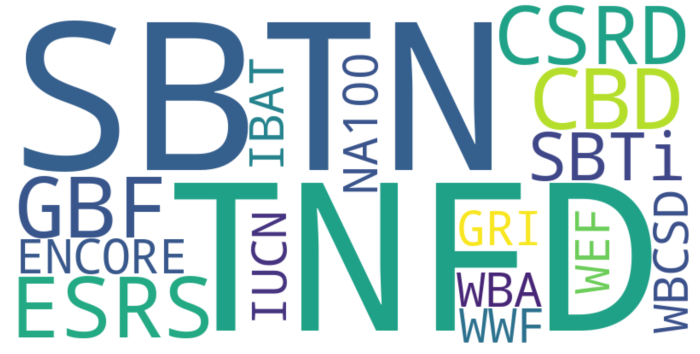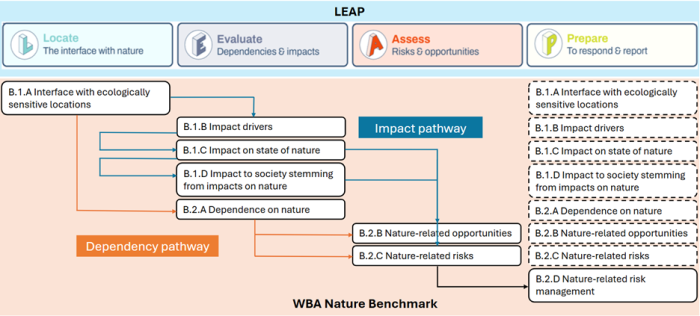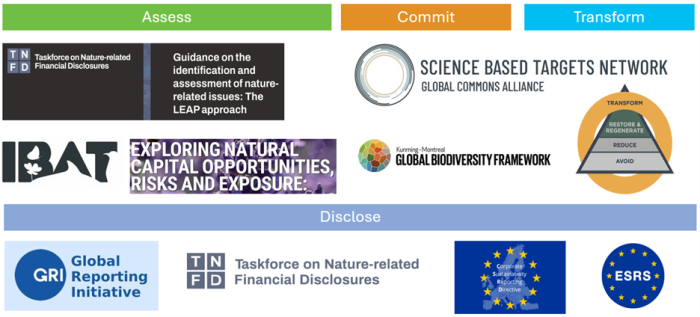Navigating nature: a practical guide to nature-related frameworks and tools
Welcome to ‘Navigating Nature’, WBA’s new nature blog series!
Part One unpacked the evolving “alphabet soup” of biodiversity initiatives. In this post, we explore how key frameworks and tools connect, and how they align with the WBA Nature Benchmark. Part Three will share insights from three years of applying the Benchmark, highlighting company practices, leading practices, and remaining gaps. Stay tuned!
Nature is fast becoming a defining issue for businesses, creating both risks and opportunities. Over half of global GDP depends moderately or heavily on nature. Ecosystem degradation—via deforestation, pollution, or overuse—can disrupt supply chains and raise costs. But restoring nature can also secure critical inputs and open new markets.
Governments are acting too. Nearly 200 countries adopted the Global Biodiversity Framework (GBF) in 2022, committing to halt and reverse nature loss by 2030. For business leaders, the message is clear: understand your relationship with nature or risk falling behind.
In Part One of this series, we introduced the “alphabet soup” of nature-related initiatives: from TNFD, SBTN, LEAP and ACT-D to ENCORE, IBAT, GRI, CSRD, ESRS, and GBF. While the number of tools and frameworks can feel overwhelming, they are largely complementary, offering a toolkit that spans data, target-setting, strategy, and disclosure. The key is knowing how to use them together.

The “alphabet soup” of biodiversity initiatives.
Making Sense of the Alphabet Soup: Introducing ACT-D
To navigate these tools, many companies are turning to ACT-D: Assess, Commit, Transform, Disclose. Promoted by Business for Nature, this framework provides a clear roadmap to becoming nature-positive:
- Assess your impacts and dependencies on nature.
- Commit to clear, science-based goals.
- Transform your operations to reduce harm and regenerate ecosystems.
- Disclose your progress transparently.
ACT-D helps connect major frameworks: Assess using LEAP, IBAT or ENCORE, Commit via SBTN, Transform with principles like AR3T, and Disclose through frameworks like TNFD and GRI, ensuring compliance with regional standards such as the EU’s CSRD and ESRS. The figure below maps how these initiatives align with ACT-D.
The ACT-D approach to nature-related strategy, and how key frameworks map to each stage
Your Nature Toolkit: What Each Framework Offers
Below is a quick overview of the key frameworks and tools featured in the figure. This “cheat sheet” will help you navigate the biodiversity landscape through the ACT-D lens:
It All Starts with “Assess”: Understanding Impacts and Dependencies
Among the ACT-D steps, Assess is the foundation, as you can’t manage what you don’t understand. In this phase, the goal is to locate where your business interacts with nature and evaluate how you depend on and impact natural systems.
- Impacts: How your operations affect ecosystems and biodiversity. There are five key impact drivers that contribute to environmental degradation: land and sea use change, pollution, resource exploitation, climate change, and invasive species.
- Dependencies: How the business relies on ecosystem services like freshwater, pollination, or soil fertility.
- Nature-related risks: The potential adverse effects on businesses from the degradation of ecosystems and biodiversity. Including physical risks (e.g. water scarcity) and transition risks (e.g. policy changes).
- Nature-related opportunities: Potential business benefits from protecting, restoring, or sustainably using ecosystems, such as new markets, cost savings, or reputational gains.
Using LEAP to Structure Assessments
TNFD’s LEAP approach, now referenced by regulators including the EU’s ESRS, provides a clear structure for biodiversity assessments. While both ACT-D and LEAP include an “Assess” step, they operate at different levels. ACT-D is a high-level roadmap for corporate action, while LEAP is a detailed methodology that fits within ACT-D’s “Assess” phase—breaking it down into four actionable steps:

Mapping WBA Nature Indicators to LEAP approach.
WBA’s Nature Benchmark aligns closely with LEAP, with indicators that cover the assessment of impacts, dependencies, and nature-related risks and opportunities. Thus, we use LEAP as the backbone, mapping WBA’s Nature Indicators to the LEAP approach (see figure below) to help illustrate the key steps and tools involved in the “Assess” phase of ACT-D.
In the Locate step, companies first identify their interactions with nature (B.1.A). In the Evaluate step, they analyze their impacts and dependencies by assessing key impact drivers (B.1.B), effects on ecosystems and species (B.1.C), societal impacts stemming from these effects (B.1.D), and dependencies on ecosystem services (B.2.A). Next, in the Assess phase, companies prioritize material nature-related risks (B.2.C) and opportunities (B.2.B), before strategically addressing them in the Prepare phase (B.2.D). Disclosure occurs throughout all phases. Two critical pathways emerge: Impact Pathway: From identifying nature interfaces (B.1.A), through impacts (B.1.B–D), leading to risks and opportunities (B.2.B–C). Dependency Pathway: From identifying nature interfaces (B.1.A) to ecosystem dependencies (B.2.A), converging similarly at risks and opportunities (B.2.B–C), ultimately guiding risk management (B.2.D).
The Next Chapter: Turning Tools into Transformation
Nature loss isn’t a distant risk, it’s unfolding now, disrupting economies, communities, and ecosystems alike. The 2025 World Economic Forum’s Global Risks Report highlighted that the top four global risks facing the world over the next decade are all environmental. For businesses, the question is no longer whether to act, but how. The good news? The tools and frameworks are here. What’s needed is the will to use them with urgency and ambition.
ACT-D gives companies a practical, integrated path forward, one that cuts through complexity and builds momentum across assessment, goal-setting, transformation, and disclosure. By aligning with global standards and embedding nature into core business strategy, companies can move beyond compliance toward leadership.
The next decade will define whether we transition to a nature-positive economy or double down on ecological decline. Businesses have a critical role to play. The path is clear. Now is the time to walk it.
